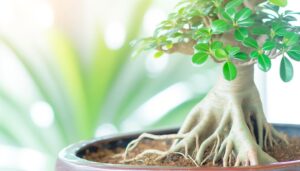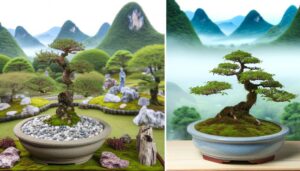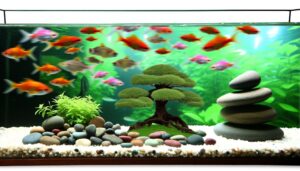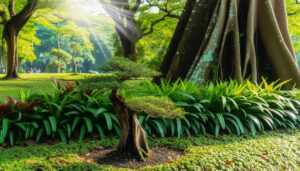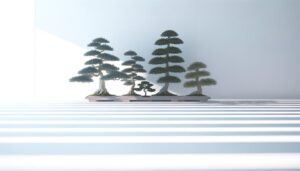5 Different Types of Bonsai Trees to Cultivate
Bonsai trees encompass a diverse array of species, each presenting unique challenges and rewards. The Flowering Cherry (Prunus serrulata) demands meticulous care, while Junipers (Juniperus) thrive with adept pruning and sunlight.
Ficus varieties are known for their robustness and adaptability, making them ideal for various indoor settings. Japanese Maple Bonsai offers stunning seasonal colors, and Pine Bonsai requires a deep understanding of intricate growth patterns.
Other notable types include the resilient Chinese Elm, picturesque Willow, challenging Cedar, and vibrant Bougainvillea. Each type necessitates specific horticultural practices, promising a deeper connection to the ancient art of bonsai cultivation.
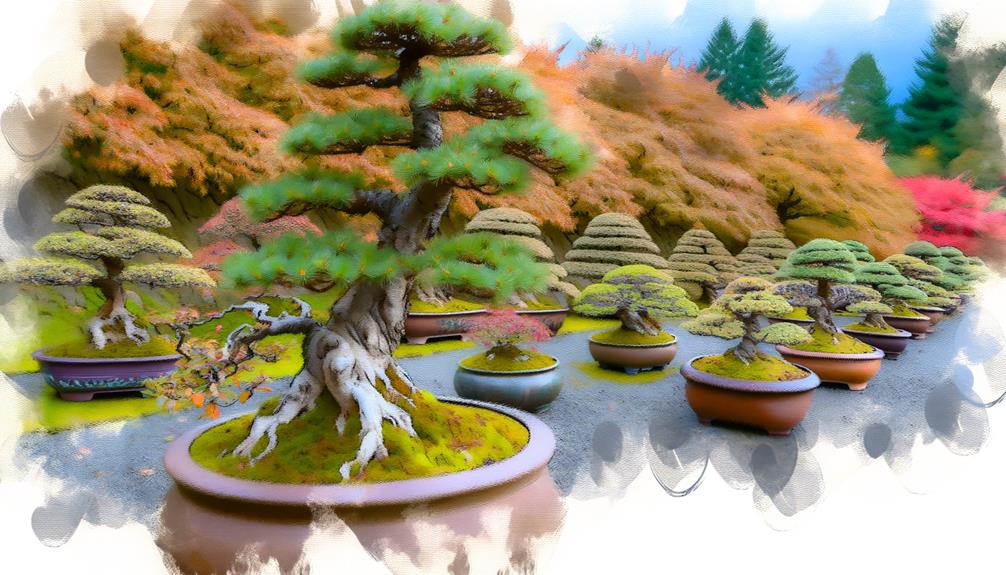
Key Takeaways
- Flowering Cherry Bonsai, known as Prunus serrulata, requires meticulous care and offers a living piece of art.
- Juniper Bonsai thrives in full sunlight, is hardy, and suitable for both indoor and outdoor environments.
- Ficus Bonsai is ideal for beginners, featuring strong roots, lush foliage, and adaptability to indoor conditions.
- Japanese Maple Bonsai offers vibrant seasonal color changes and requires expert pruning and meticulous watering.
- Pine Bonsai demands deep understanding, intricate pruning, and precise care for harmonious growth and aesthetic appeal.
Flowering Cherry Bonsai
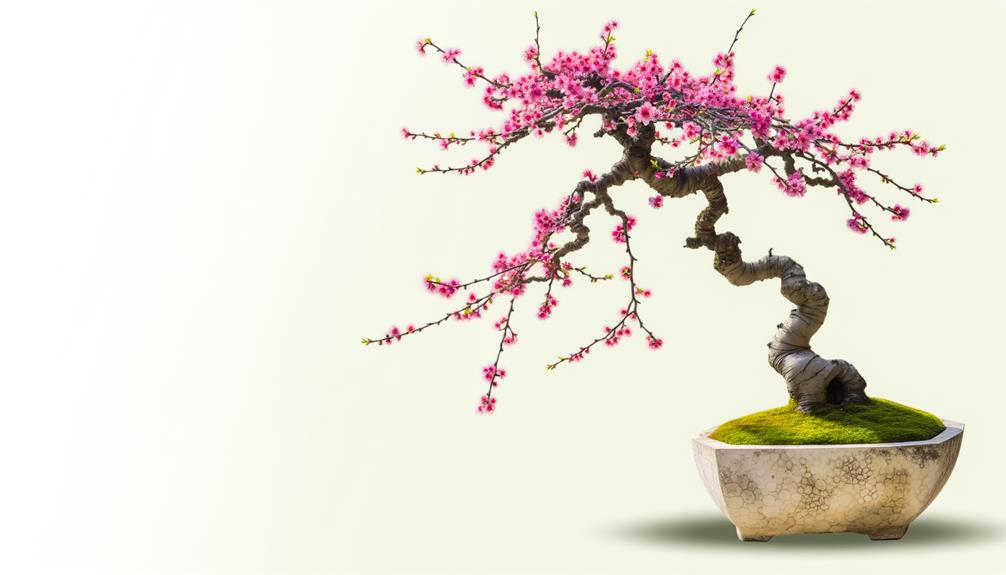
Flowering Cherry Bonsai, known scientifically as Prunus serrulata, captivates enthusiasts with its delicate blossoms and intricate branch structures, making it a quintessential choice for bonsai cultivation.
This species, renowned for its graceful pink or white flowers, requires meticulous care to achieve its full aesthetic potential. The cultivation involves precise pruning, wiring, and root management to maintain the miniature tree's elegant form.
Ideal growth conditions include well-draining soil, consistent moisture, and adequate sunlight, replicating its natural habitat. Seasonal attention is paramount, as spring blossoms necessitate specific feeding regimes and winter dormancy requires protection from extreme cold.
Mastery in creating a Flowering Cherry Bonsai results in a living piece of art, embodying both nature's beauty and human craftsmanship.
Juniper Bonsai
Renowned for its rugged beauty and resilience, the Juniper Bonsai, scientifically classified as Juniperus, stands as a favorite among bonsai enthusiasts for its versatility and ease of cultivation.
Juniper Bonsai trees can be shaped into a variety of forms, including the iconic cascading style, thanks to their flexible branches. Their needle-like foliage, which ranges in color from deep green to blue-green, adds to their aesthetic appeal.
Junipers thrive in full sunlight and require well-draining soil to prevent root rot. Regular pruning is essential to maintain their form, while careful wiring helps guide branch placement.
Importantly, Junipers are also hardy, tolerating a range of temperatures, making them suitable for both indoor and outdoor environments.
Ficus Bonsai
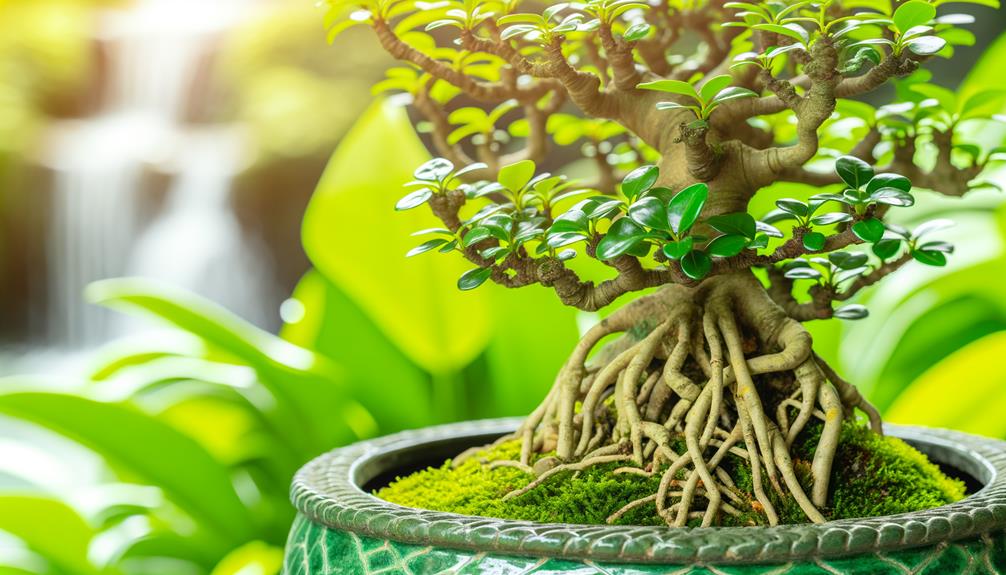
Following the rugged appeal of the Juniper, the Ficus Bonsai, known for its strong root system and lush foliage, presents another alluring option for bonsai enthusiasts seeking both beauty and resilience.
Characterized by its aerial roots and robust trunk, the Ficus Bonsai can adapt to various indoor conditions, making it an ideal choice for beginners and seasoned practitioners alike. Its leaves, typically small and glossy, offer a rich green palette that enhances any setting.
The Ficus species, including Ficus retusa and Ficus benjamina, are particularly revered for their ability to be shaped into intricate forms, maintaining structural integrity. Cultivating a Ficus Bonsai requires diligent pruning, adequate lighting, and balanced watering to achieve its full aesthetic potential, embodying both art and nature.
Japanese Maple Bonsai
The Japanese Maple Bonsai is renowned for its striking seasonal color changes, which shift elegantly from vibrant spring greens to fiery autumn hues.
Expert pruning and shaping are essential to maintain its delicate structure and enhance its aesthetic appeal, requiring a deep understanding of the tree's growth patterns.
Proper soil composition and meticulous watering schedules are vital for sustaining the health and vigor of this exquisite bonsai species.
Seasonal Color Changes
Japanese Maple Bonsai exhibit a mesmerizing transformation in foliage color throughout the seasons, enchanting bonsai enthusiasts with their vibrant autumnal reds, oranges, and yellows. This seasonal metamorphosis is a result of the tree's adaptive physiology and genetic predispositions. During spring and summer, the leaves typically display a lush green hue, benefiting from chlorophyll production.
As temperatures drop and daylight decreases in autumn, chlorophyll breaks down, revealing anthocyanins and carotenoids, pigments responsible for the striking red, orange, and yellow tones. The exact coloration can vary with specific cultivars and environmental factors such as soil pH and light exposure.
This dynamic color change not only enhances the visual appeal but also offers a deeper connection to the natural cycles, fostering appreciation and admiration among bonsai caretakers.
Pruning and Shaping
Mastering the art of pruning and shaping is essential for maintaining the Japanese Maple Bonsai's aesthetic appeal and structural integrity throughout its seasonal transformations. Regular pruning promotes robust branch development and refined leaf size, crucial for its delicate, intricate appearance. Utilize sharp, sterilized tools to make clean cuts, reducing stress and potential for disease. Structural pruning should be done during the dormant winter months, while maintenance pruning is ideal in the growing season.
| Pruning Task | Best Timing |
|---|---|
| Structural Pruning | Winter (Dormant Season) |
| Maintenance Pruning | Spring and Summer |
| Leaf Pruning | Late Spring |
| Root Pruning | Early Spring |
| Wiring and Shaping | Throughout Growing Season |
Careful attention to these techniques will optimize your Japanese Maple Bonsai's growth, highlighting its natural beauty.
Soil and Watering
Optimizing soil composition and precise watering techniques is essential in fostering the health and vigor of your Japanese Maple Bonsai. The soil must provide excellent drainage while retaining sufficient moisture, typically achieved through a blend of akadama, pumice, and lava rock.
Watering needs to be meticulous, ensuring the soil remains consistently moist but not waterlogged. Here are three vital aspects to keep in mind:
- Soil Composition: Use a well-draining mix with components like akadama (50%), pumice (25%), and lava rock (25%).
- Watering Frequency: Water when the top inch of soil feels slightly dry, adjusting based on seasonal variations.
- Water Quality: Utilize rainwater or distilled water to avoid harmful mineral buildup.
Mastering these elements guarantees strong growth and lasting beauty.
Pine Bonsai
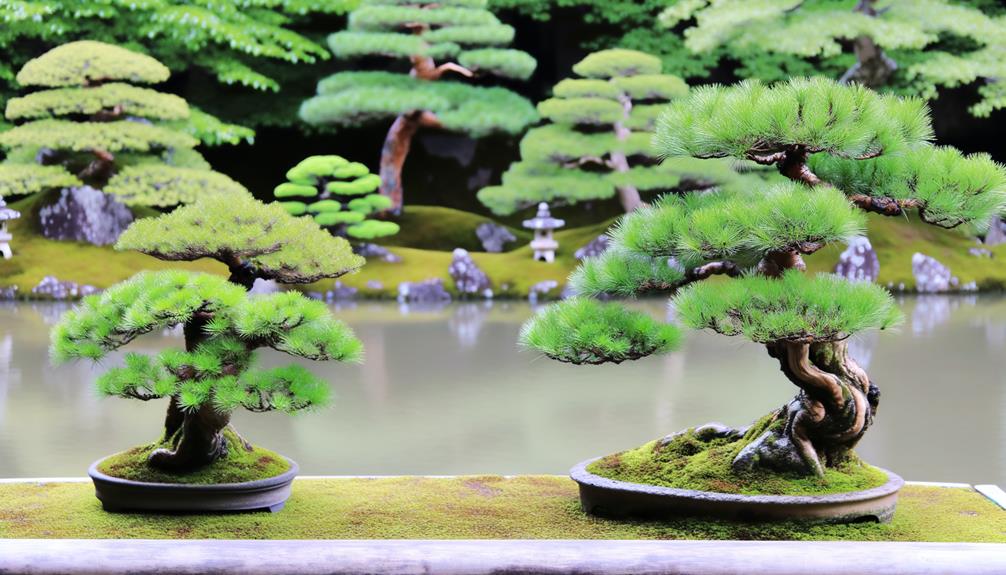
Cultivating Pine Bonsai requires a deep understanding of their growth patterns, intricate pruning techniques, and meticulous care to achieve their iconic stately appearance. These conifers, revered for their majestic, rugged form, demand precise attention to detail.
Pruning is critical, involving the careful removal of old needles and strategic branch trimming to shape the tree harmoniously. Wiring is another essential technique, applied to guide branch growth and enhance aesthetic appeal.
Soil composition must be meticulously balanced, ensuring adequate drainage while retaining necessary nutrients. Watering schedules must be rigorously adhered to, as pines are sensitive to both drought and overwatering.
Understanding the symbiotic relationship with mycorrhizal fungi further enhances their health and vigor, making Pine Bonsai an endeavor of both science and art.
Azalea Bonsai
Why do Azalea Bonsai captivate enthusiasts with their stunning, vibrant blooms and intricate, delicate forms that demand a careful approach to pruning, watering, and soil management to thrive? Their allure lies in several key factors:
- Blooming Season: Azalea Bonsai produce an abundance of colorful flowers, often in pinks, reds, and whites, creating a breathtaking display during their blooming season. Proper care guarantees a prolonged and prolific bloom.
- Pruning Techniques: To maintain their intricate forms, precise pruning is essential. This involves regular pinching and trimming to promote desired shapes and encourage flower production.
- Soil and Watering Needs: Azaleas require well-draining, acidic soil and consistent moisture. Balancing these elements is essential to prevent root rot and promote robust growth.
These aspects make Azalea Bonsai both challenging and rewarding for dedicated bonsai artists.
Elm Bonsai
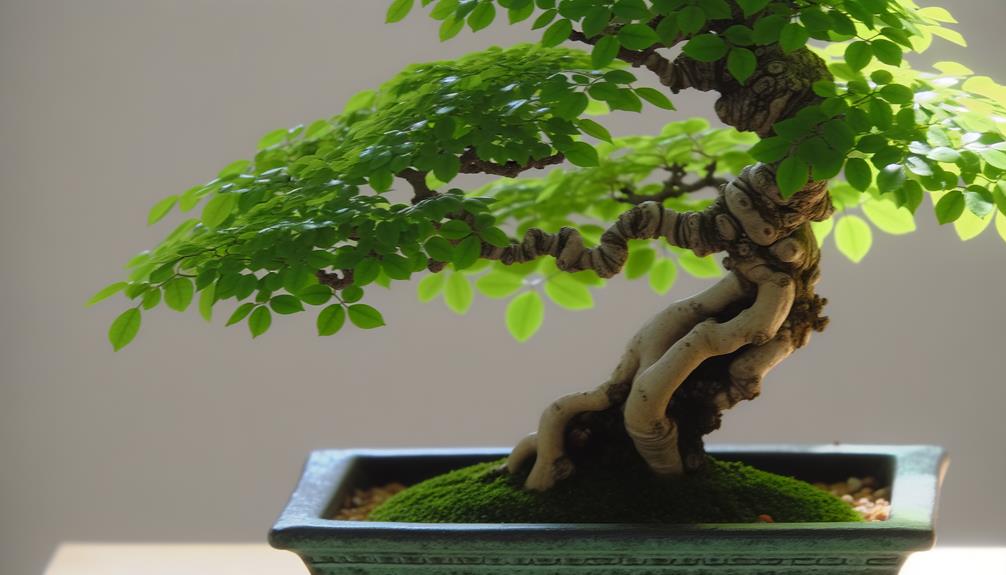
Elm Bonsai are distinguished for their graceful branching and delicate leaves. They require meticulous care and maintenance to thrive in various environments.
Key to their success is understanding the specific needs of popular varieties such as the Chinese Elm and Zelkova. Each has distinct growth patterns and aesthetic attributes.
Proper pruning, watering, and soil management are essential to cultivating these resilient yet elegant trees into stunning miniature masterpieces.
Care and Maintenance
Proper care and maintenance of an Elm Bonsai demand a meticulous approach to watering, pruning, and positioning to guarantee the tree thrives and exhibits its characteristic elegance.
To guarantee your Elm Bonsai remains healthy, consider the following:
- Watering: Maintain consistent moisture in the soil without waterlogging. Use the fingertip test to check soil dampness and water accordingly, ideally in the morning.
- Pruning: Regularly trim back new shoots to maintain shape and encourage ramification. Use sharp, sterile tools to prevent disease.
- Positioning: Place the Elm Bonsai in a well-lit area with indirect sunlight, making sure it receives at least six hours of light daily. Protect it from extreme temperatures and drafts.
Adhering to these guidelines will foster a robust and aesthetically pleasing Elm Bonsai.
Popular Varieties
Among the myriad of Elm Bonsai varieties, the Chinese Elm (Ulmus parvifolia) stands out for its intricate foliage and adaptability, making it a favorite among bonsai enthusiasts. Its small, serrated leaves create a lush, verdant canopy, while its fine, fibrous roots ensure robustness and ease of shaping.
The tree's natural propensity for producing new shoots allows for extensive pruning and styling, essential for bonsai aesthetics. Moreover, the Chinese Elm's resilience to varying climatic conditions, from temperate to tropical, enhances its versatility. The textured bark, evolving from smooth to rough with age, adds a compelling visual element.
This combination of beauty and hardiness makes the Chinese Elm not just popular, but quintessential in the art of bonsai.
Chinese Banyan Bonsai
The Chinese Banyan Bonsai, recognized for its intricate aerial root structures and dense foliage, exemplifies the artistic and technical mastery needed in bonsai cultivation. This species, Ficus microcarpa, thrives in warm and humid conditions, making it perfect for indoor growth. Its aerial roots, descending from branches to the soil, create a striking visual impact, while its strong leaves provide a lush canopy.
Key aspects of Chinese Banyan Bonsai care include:
- Light: Requires ample, indirect sunlight to promote healthy growth.
- Watering: Maintain consistent moisture levels, avoiding overwatering.
- Pruning: Regular trimming to shape the bonsai and promote root development.
Mastering these elements ensures a flourishing and captivating Chinese Banyan Bonsai, a true demonstration of bonsai artistry.
Willow Bonsai
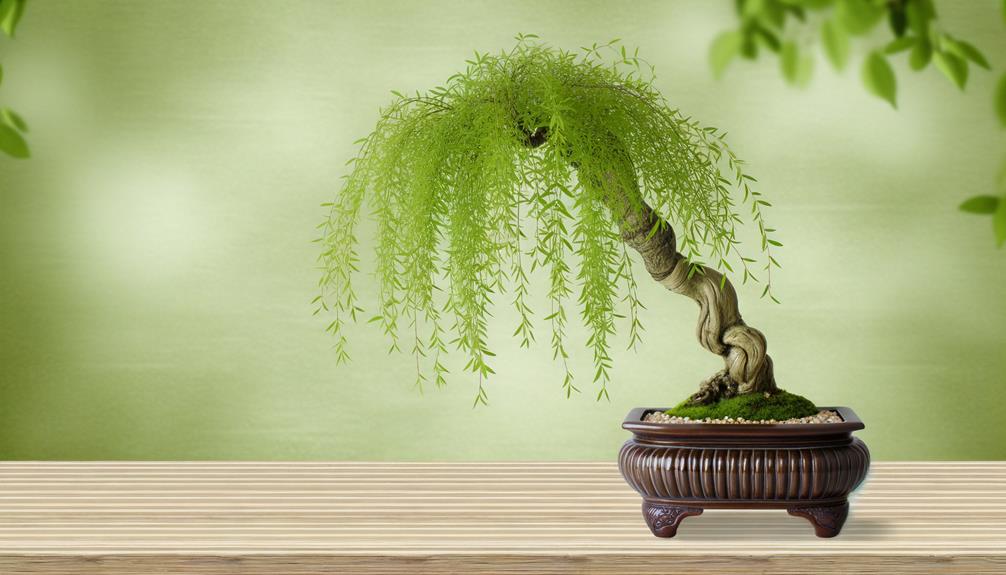
Willow Bonsai trees captivate enthusiasts with their graceful, cascading branches and delicate, lance-shaped leaves, offering a unique aesthetic that sets them apart from other bonsai varieties.
Successful growth and maintenance of Willow Bonsai require specific care, including regular watering and pruning to manage their vigorous growth and prevent root rot.
Attention to these details guarantees the Willow Bonsai thrives, maintaining its striking visual appeal and structural integrity.
Growth and Maintenance Tips
Cultivating a Willow Bonsai requires meticulous attention to its watering needs, as this species thrives in consistently moist soil conditions. Maintaining an excellent growth and crucial health involves a combination of precise techniques and regular care.
Here are three essential tips:
- Watering: Sustain soil moisture by watering daily, especially during warmer months. Utilize a moisture meter to prevent overwatering, which can lead to root rot.
- Pruning: Regularly trim the branches to control growth and shape. Focus on removing dead or overgrown branches to promote healthy development.
- Fertilization: Apply a balanced, slow-release fertilizer every four to six weeks during the growing season. This guarantees the tree receives necessary nutrients for robust growth.
Adhering to these practices will support a thriving Willow Bonsai.
Unique Aesthetic Features
Beyond the meticulous care required for its growth, one of the most enchanting aspects of a Willow Bonsai lies in its unique aesthetic features.
The cascading branches, adorned with delicate, lance-shaped leaves, create a mesmerizing weeping effect that evokes serenity and grace.
This bonsai's slender, pliable twigs allow for intricate styling, offering enthusiasts the opportunity to create dynamic, flowing shapes that mimic natural willow trees.
The bark, often displaying a textured, rugged appearance, contrasts beautifully with the tree's ethereal foliage.
Seasonal changes further enhance its allure, as the lush green leaves of summer shift to a striking golden hue in autumn.
The Willow Bonsai's inherent elegance and adaptability make it a cherished centerpiece in any bonsai collection.
Cedar Bonsai
Cedar Bonsai, known for their majestic appearance and aromatic foliage, represent a sophisticated choice for bonsai enthusiasts seeking to cultivate a tree that combines both aesthetic beauty and horticultural challenge. These evergreens require specific care to thrive and exhibit their full potential.
Key aspects of Cedar Bonsai cultivation include:
- Soil Composition: Utilize well-draining soil to prevent root rot, ensuring a mix of akadama, pumice, and lava rock.
- Watering Needs: Maintain consistent moisture levels without waterlogging; deep watering is recommended to encourage root growth.
- Pruning Techniques: Regular pruning is essential to shape the tree and maintain its miniature form; be mindful of the tree's natural growth patterns.
Understanding these factors will enhance the cultivation experience and result in a stunning Cedar Bonsai.
Bougainvillea Bonsai
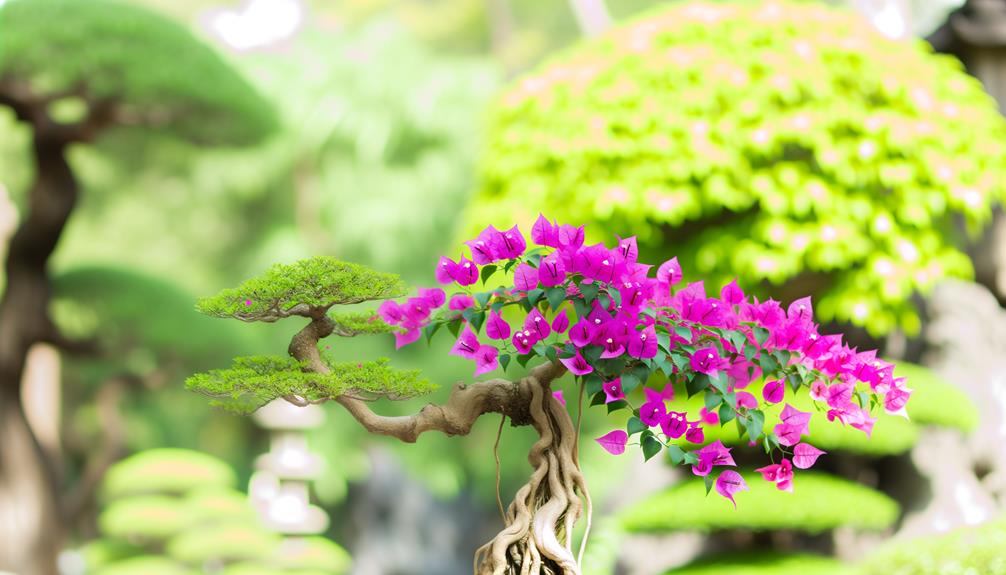
Bougainvillea Bonsai, admired for their vibrant bracts and resilient nature, offer a unique opportunity for bonsai artists to create stunning displays of color and form. These tropical plants, native to South America, are particularly cherished for their striking, papery bracts that come in shades of magenta, red, orange, and purple.
Technically a woody vine, Bougainvillea requires meticulous pruning to maintain its miniature tree-like structure. The plant thrives in well-draining soil and requires ample sunlight to promote blooming. Regular watering is essential, though it is essential to avoid waterlogged conditions.
Due to their vigorous growth, Bougainvillea Bonsai demand consistent attention but reward with spectacular, long-lasting blooms, making them a favorite among dedicated bonsai enthusiasts.
Conclusion
To sum up, the varied assortment of bonsai trees showcases a captivating tapestry of botanical artistry and horticultural finesse.
Every type, from the fragile Flowering Cherry to the sturdy Cedar, embodies a distinctive combination of visual charm and cultural importance.
The careful nurturing of these tiny tree wonders, whether it's the graceful Japanese Maple or the detailed Chinese Banyan, illustrates a deep commitment to safeguarding nature's beauty in a polished and regulated manner.
The world of bonsai, therefore, serves as a proof of human creativity and respect for the natural world.

